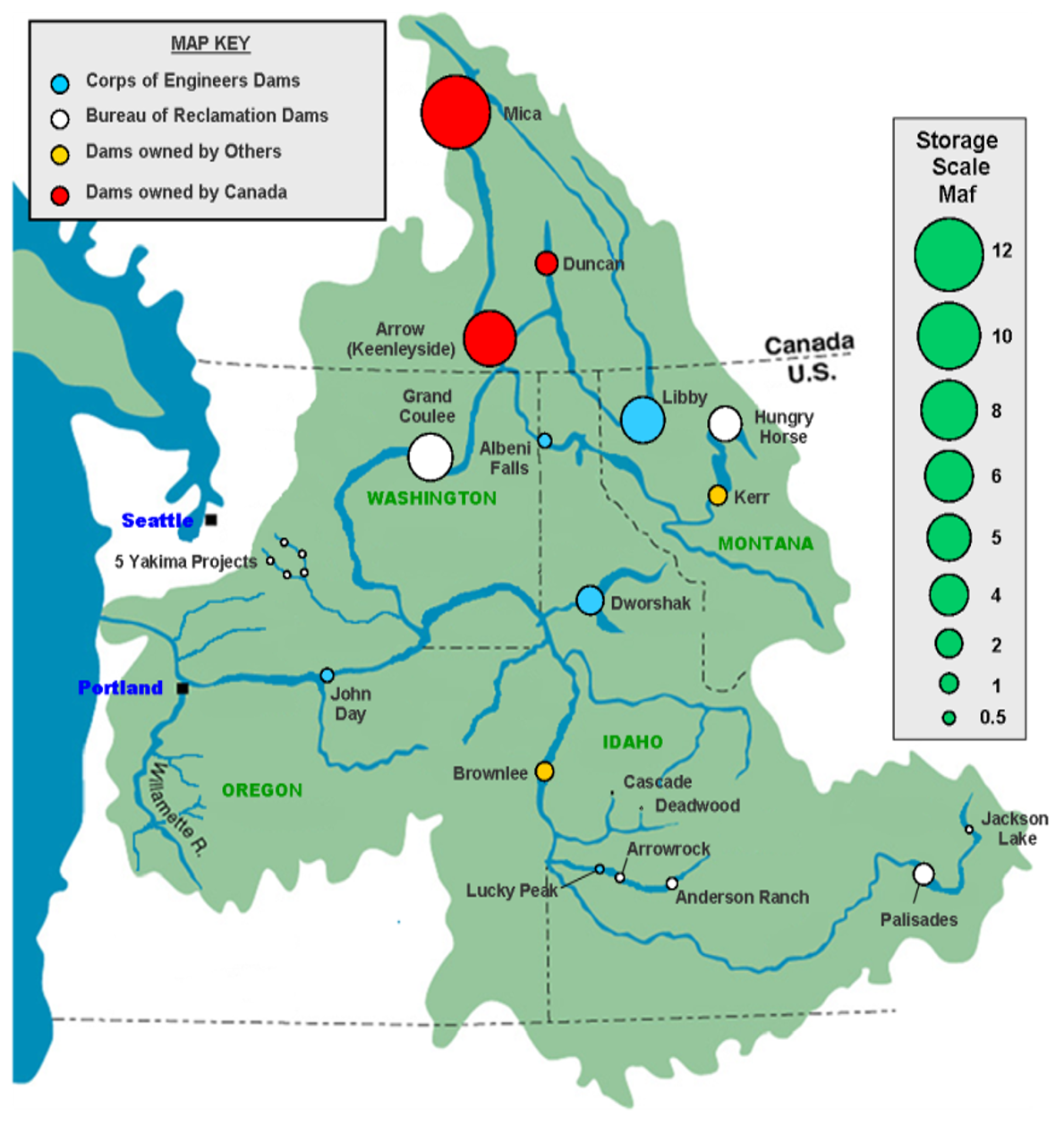
Overlooking the Columbia River.
| |
|
Columbia River Basin flooding
Flooding typically occurs when runoff from rain or snowmelt increases river flows enough that water inundates riverbanks and flood plains. Heavy or continuous rain west of the Cascade Range generates the greatest amount of runoff from November to March. Snowmelt east of the Cascades may cause flooding from May to July. Risk of flood damage increases in the densely populated and highly developed areas in or near the Columbia River’s flood plain, such as Portland, Ore., and Vancouver, Wash.
Federal agencies in the Pacific Northwest use the storage space in U.S. and Canadian reservoirs to manage spring runoff from the upper Columbia River Basin. Approximately 30% of average annual runoff originates in the Canadian portion of the basin, but this average increases to almost 40% during large flood events.
|
One basin working together
The Columbia River Treaty (CRT) is an international agreement between the United States and Canada, signed in 1961, that establishes coordination obligations between the countries for flood risk management and hydroelectric energy production. International coordination has yielded environmental benefits in the Columbia River Basin. Currently, the United States and Canada are working to modernize the CRT regime, which includes several additional agreements used to implement the Treaty. Regardless of whether the countries reach an agreement, the United States will be prepared to continue to implement the Treaty, including the use of real-time flood risk management (FRM) operations as needed to protect its citizens and communities.
Managing flood risks under the Columbia River Treaty
The CRT allows for U.S. and Canadian water management agencies to use seasonal runoff volume forecasts to formally plan for the storage and release of water in Canadian reservoirs under the CRT, in coordination with other U.S. reservoirs to reduce regional flood risk.
Operating across the seasons
In the Pacific Northwest, water managers begin lowering reservoirs from September to December to predetermined levels to prepare to capture spring runoff. Forecasters estimate the amount of runoff, but since there is uncertainty about how much storage space water managers will need for FRM, they continue lowering reservoir levels from January through the spring. As the snow begins to melt, usually in April, operators refill the reservoirs by capturing the runoff in the storage space made available through earlier releases. Operators across the system of Columbia River Basin dams coordinate the refill of the reservoirs to meet system needs including flood risk management and other benefits such as increased flows for fish and other aquatic species, hydropower, navigation, recreation, irrigation and water supply.
It takes a system
 No single agency or action can manage flood events alone. An entire system—with both human-made and natural features—contributes to risk reduction. Most of the system flood storage space for the Columbia River Basin is available from eight U.S. dams (Libby, Hungry Horse, Dworshak, Brownlee, Seli’š Ksanka Qlispe’, Albeni Falls, Grand Coulee and John Day) and the three Treaty dams in Canada (Mica, Duncan, and Arrow—also known as Keenleyside). Dozens of other dams provide local flood risk management and all dams in the system provide water for other benefits noted above. Additionally, levees serve as barriers between floods and developed areas.
No single agency or action can manage flood events alone. An entire system—with both human-made and natural features—contributes to risk reduction. Most of the system flood storage space for the Columbia River Basin is available from eight U.S. dams (Libby, Hungry Horse, Dworshak, Brownlee, Seli’š Ksanka Qlispe’, Albeni Falls, Grand Coulee and John Day) and the three Treaty dams in Canada (Mica, Duncan, and Arrow—also known as Keenleyside). Dozens of other dams provide local flood risk management and all dams in the system provide water for other benefits noted above. Additionally, levees serve as barriers between floods and developed areas.
Moving into the future – transitioning to “Called Upon” obligations under the CRT
The Treaty provisions regarding Canada’s obligations to operate its reservoirs for U.S. flood risk management change on September 16, 2024. It is important to note that Columbia River Treaty negotiations are ongoing with a goal of reaching a modernized agreement with Canada, which could clarify operations after September 16, 2024. The United States secured an obligation from Canada to provide a degree of flood risk management when the Treaty was originally signed. That obligation continues so long as Canada has dams in the basin that contribute to flood risk reduction in the United States. The first 60 years of that obligation were handled on a pre-planned and pre-paid basis. In 2024, the 60 years of pre-planned flood storage in the Canadian Treaty dams sunsets and is replaced with terms that allow the United States and Canada to coordinate FRM operations and payment for FRM differently, by using what is known as "Called Upon" or real-time operations. This provision means that the United States can call upon Canada for assistance when necessary to meet U.S. flood risk management needs. The United States would need to continue to operate its reservoirs to reduce flood peaks in periods when it calls on Canadian reservoir storage. The Treaty has a corresponding change on the payment side, which would require the United States to compensate Canada based on the economic loss shown to arise directly from any foregone use of the relevant reservoir space during the flood period.
The major dams in the Columbia River Basin.
| |
Explaining Flood Risk
Flood risk is the probability that an area will flood. This risk is the combination of the probability that the amount of runoff will be large enough to cause flooding, the ability to reduce human risks and damage from a flood, and the actual consequences should flooding occur. While federal dams may reduce flooding, they cannot eliminate it.
|
|
The U.S. Government is proactively negotiating a modernized agreement that would continue to benefit both countries. Pending completion of the negotiations, the U.S. Army Corps of Engineers and the Bureau of Reclamation will rely on the existing Treaty and laws when operating and maintaining their projects to meet all Congressionally authorized responsibilities.
| |
Treaty negotiations
The coordinated operation of the dams and reservoirs under the CRT has provided significant benefits for both countries.
The Treaty required Canada to build three storage dams with 15.5 million acre-feet (maf) of storage and allowed the U.S. to construct Libby Dam with 5 maf (6.1 km3) of storage. When the Canadian dams were completed the U.S. pre-paid for 60 years (1964-2024) with 8.95 maf of pre-planned flood control space for the United States.
The Treaty also requires the U.S. and Canada to share equally the downstream power benefits produced in the United States from the use of Canadian Treaty storage. The Treaty Regime allows both countries to realize other benefits, such as those for endangered species and the ecosystem through cooperative measures under the Treaty regime.
While the CRT has no specified end date, the flood risk coordination provisions will change in September 2024 from requiring pre-planned to allowing for an ad hoc or real time FRM regime. Either Canada or the United States may unilaterally terminate most provisions of the Treaty with a minimum of 10 years’ advance notice. However, the post September 2024 FRM provisions cannot be terminated.
|
|
The agencies are considering uncertainties regarding real-time flood risk management operations that could arise without pre-planned storage in Canada or under changes to CRT following ongoing negotiations. As more information is known about specific Canadian operations, the agencies will communicate with stakeholders and Tribes on changes in flows across the border from Canada and any potential resulting impacts.
 With or without a modernized Treaty regime, the U.S. has the right to access Canadian storage after September 2024, which includes calling on Canada when conditions warrant. The United States will adapt to any increased uncertainty in flows across the border, which may at times impact those who are accustomed to the certainty in the benefits provided by the system’s operation.
With or without a modernized Treaty regime, the U.S. has the right to access Canadian storage after September 2024, which includes calling on Canada when conditions warrant. The United States will adapt to any increased uncertainty in flows across the border, which may at times impact those who are accustomed to the certainty in the benefits provided by the system’s operation.
The relative capacity of major Columbia Basin storage dams. A significant portion of storage is in Canada.
Visit: www.nwd.usace.army.mil/CRWM/Columbia-River-Treaty/ for more information.